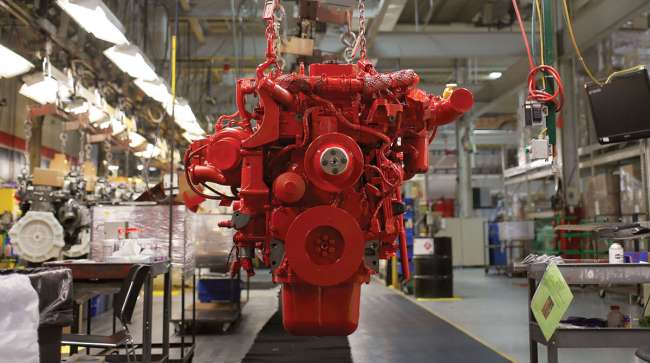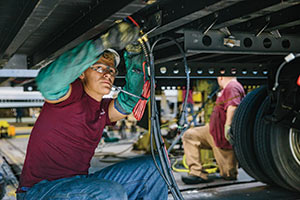Senior Reporter
Equipment Manufacturers Shift to Counter Supply Chain Uncertainty

[Stay on top of transportation news: Get TTNews in your inbox.]
Some major equipment manufacturers said they are rethinking their operations and taking new steps to confront volatility in the supply chain.
The availability of parts varies month by month. Raw material costs are climbing, pushing up equipment prices. Possibly 30,000 heavy-duty trucks are red tagged awaiting the finishing piece.
About 166,000 have been sold in the U.S. through September. Fleets would have bought far more — if only they could.
“There are a bunch of new problems that we weren’t seeing before,” Cummins Inc. Chairman and CEO Tom Linebarger said during the company’s latest earnings call.
Cummins, the largest independent engine maker, counted all the Class 8 truck manufacturers selling in the U.S., except Hino Motors, as customers, WardsAuto.com reported for the first half of 2021.
“Do we have enough inventory in the right places? Are we outsourced in places we should be insourced?” Linebarger said. “And then, of course, with the trade challenges between countries. Are we relying too much on cross-border trade? So all those things now are in our strategy, looking forward about how we want to reposition our supply chain.”
Paccar Inc. is the leading customer for Class 8 engines from Cummins. CEO Preston Feight said in Paccar’s third-quarter earnings call the company has started to see some good news, working with the supply base.
He said the company is buying chips from alternative sources and chip brokers, re-engineering different chips or taking places where maybe two chips were required and “re-engineering them into requiring only one chip. We’re working with semiconductor manufacturers themselves in our second, third, fourth tier to come up with good solutions that are robust and high quality.”
Feight expects gradual and steady recovery in the supply chain, rather than a hockey stick-shaped improvement.
Linebarger suggested some consolidation is likely. “We need to make sure that we can be the reliable supplier that we need to be for our customers. So we will be looking at that and thinking through what the right way to position ourselves in different supply chains is.”
Bloomberg News reported base metals (used in construction and manufacturing) climbed higher on Nov. 8, led by aluminum, as investors bank on increasing need for industrial materials to support billions of dollars in U.S. infrastructure spending.

A worker on the production line at the Wabash trailer manufacturing plant in Lafayette, Ind. (Wabash National)
At trailer maker Wabash, formerly Wabash National Corp., now is the time to lock in its relationship with a key supplier. The company announced Nov. 9 it shortened its name and would now bring products to market as Wabash. Its stock will still trade as WNC on the New York Stock Exchange.
Lafayette, Ind.-based Wabash announced an agreement running through 2031 with Norway-based Hydro, a leader in the global aluminum and energy industry with 30,000 employees in more than 140 locations and 40 countries.
“We believe this partnership with Hydro will help us address our aluminum supply needs in the near-term to aid in Wabash National’s ability to increase production of dry van trailers and refrigerated trailers, flatbed trailers and truck bodies with molded structural composite technology,” Richard Mansilla, vice president of global supply chain at Wabash, said in a release.
Hydro has supplied it with aluminum extrusions for over 12 years, Wabash noted. The enhanced supply of aluminum from Hydro supports the company’s recent announcement of additional dry van capacity, which is set to come online at the beginning of 2023, as well as future capacity for molded structural composite products like panels for increased thermal performance in refrigerated semi-trailers and refrigerated truck bodies.

In this episode, host Michael Freeze asks, how are companies saving money by leasing trucks rather than owning? For answers, we speak with Jim Lager of Penske Truck Leasing and Al Barner of strategic fleet solutions at Fleet Advantage. Hear a snippet above, and get the full program by going to RoadSigns.TTNews.com.
U.S. lawmakers passed the country’s biggest infrastructure package in decades on Nov. 5, unleashing $550 billion of fresh spending on roads, bridges, public transit and other projects in the coming years.
“The market is projecting a significant amount of new investment in various projects that will require more copper and base metals,” TD Securities analyst Bart Malek said.
Meanwhile, experts at Gartner speaking at a recent conference, excerpts of which were posted online, forecast likely trends affecting supply chain planners over the next decade.
“Supply chain planners will have to work differently. They will need to learn much more on how they can model the supply chain: the setups, the constraints, the dependencies. How they can model the business priorities: Which customer is more important? Which products are more important?” said Pia Orup Lund, director analyst at Gartner.
“This will also affect skills: The organizational setup will need to have even more network-oriented end-to-end planners with a very good understanding of technologies and how they work,” she said.
Want more news? Listen to today's daily briefing below or go here for more info:

